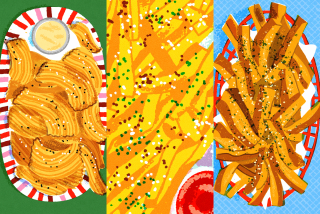Eight Easy Pieces
- Share via
It doesn’t take an Einstein to figure out you can save money by purchasing whole chickens instead of parts. And you don’t need to be a seasoned butcher to cut a bird into pieces. All it takes is a sharp boning knife and a little practice.
Remove the neck and giblets from the chicken and reserve. These parts, except for the liver, may be used along with the back to make stock. (Liver causes the stock to become dark and cloudy.)
Rinse the whole bird well with cold water and pat it dry with paper towels. Place the bird on a work surface with the legs toward you.
Grasp one leg and pull it away from the body. Cut through the skin where the thigh joins the body to expose the joint (Step 1). Break the joint by twisting the thigh outward from the body and cut the leg off with the knife. Repeat this procedure to remove the other leg.
To separate the drumstick from the thigh, place the leg on the work surface skin-side down and bend it to determine the location of the joint. Cut through the skin at this point, bend the leg back to expose the joint, then cut through it (Step 2) and the skin underneath.
Turn the chicken around, lift the wing and slit the skin where it joins the body. Cut through the joint (Step 3) and remove; repeat to detach the other wing.
Separate the backbone from the breast by cutting along each side of the backbone between the rib joints (Step 4). The back may be left whole or bent in half (Step 5) and cut apart where it breaks naturally.
This leaves only the breast. To cut it in half, place on the work surface with the pointed end away from you, then cut through the white cartilage at the broad end of the keel bone (Step 6). Lift the breast and push from the underside until this bone pops loose.
Run your thumb and forefinger down either side of the bone (Step 7), then pull it free. Cut along the line where the bone was removed to divide the breast in half (Step 8).
You now have eight pieces of chicken: two legs, two thighs, two wings and two half-breasts, plus the backbone, and reserved neck and giblets (Step 9).
Remember that chickens are particularly likely to carry salmonella bacteria, a common cause of food poisoning. (Cooked chicken isn’t a problem; the bacteria are killed at 185 degrees.) When you finish handling raw chicken (or any raw meat), immediately wash your hands, the work surface, all the utensils you used and anything else you touched while working, such as a refrigerator door, with soap and hot water.
More to Read
Eat your way across L.A.
Get our weekly Tasting Notes newsletter for reviews, news and more.
You may occasionally receive promotional content from the Los Angeles Times.





